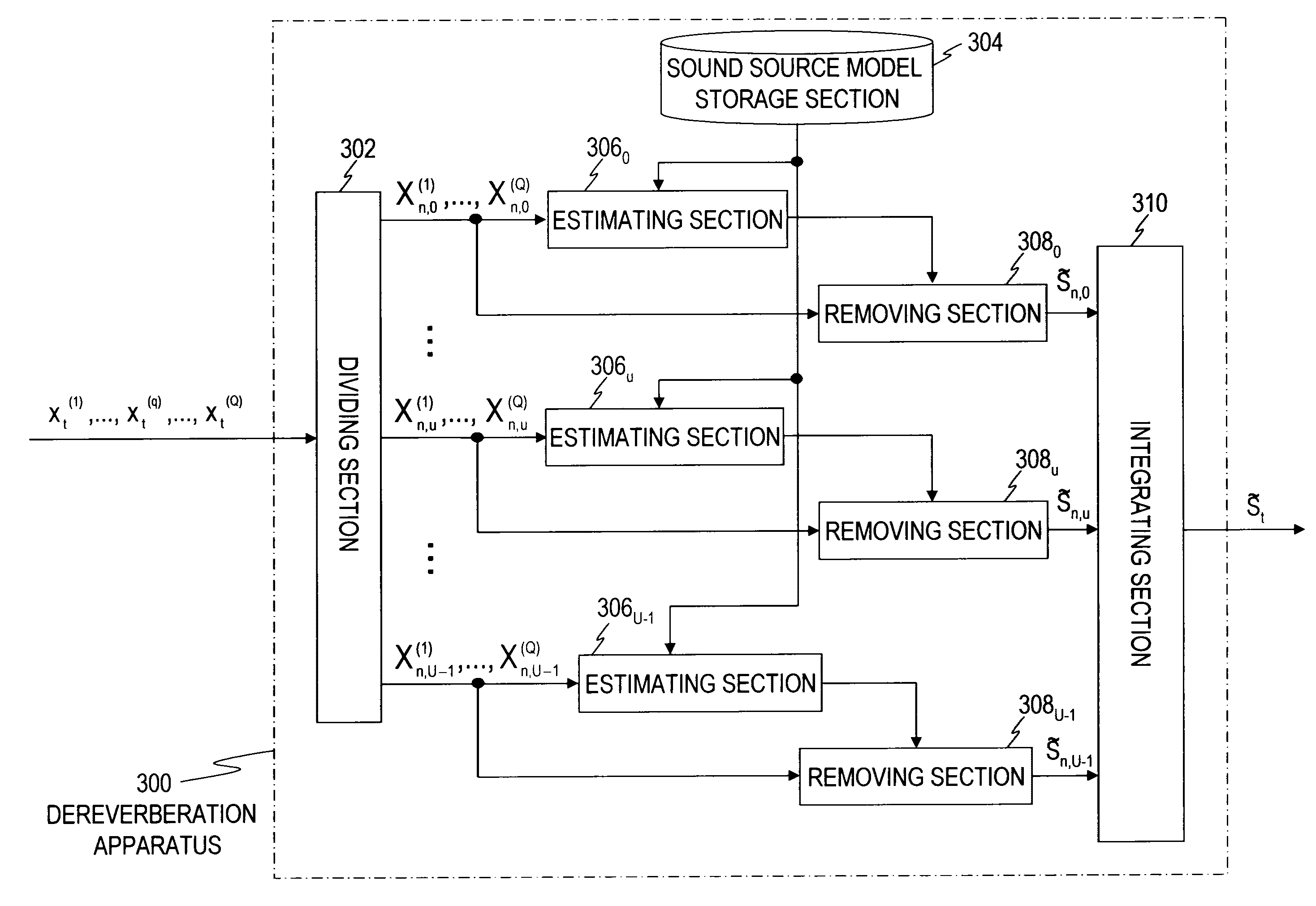Dereverberation apparatus, dereverberation method, dereverberation program, and recording medium
- Summary
- Abstract
- Description
- Claims
- Application Information
AI Technical Summary
Benefits of technology
Problems solved by technology
Method used
Image
Examples
embodiment 1
[0038]FIG. 3 is a block diagram showing a dereverberation apparatus 300 according to an embodiment 1, and FIG. 4 shows a general flow of a process performed by the dereverberation apparatus 300. As shown in FIG. 3, the dereverberation apparatus 300 according to the embodiment 1 comprises a dividing section 302 that divides an observation signal into U frequency bands, a sound source model storage section 304, an estimating section 306u (u=0, . . . , U−1) provided for each frequency band, a removing section 308u provided for each frequency band, and an integrating section 310.
[0039]The dividing section 302 divides the observation signal into individual frequency bands and down-samples the observation signals to output frequency-specific observation signals. The dividing section 302 according to the embodiment 1 divides the observation signal on a frequency band basis by applying a short-time analysis window to the observation signal by temporally shifting the short-time analysis wind...
embodiment 2
[0083]In the embodiment 1, the observation signal is convolved with the dereverberation filter estimated for each frequency band to achieve dereverberation. However, as is known, dereverberation carried out by estimating the reverberation signal and determining a difference signal that is the difference between the energy of the observation signal and the energy of the reverberation signal is less susceptible to the estimation error of the dereverberation filter than the dereverberation method according to the embodiment 1. For example, such a method is described in K. Kinoshita, T. Nakatani, and M. Miyoshi, “Spectral subtraction steered by multi-step forward linear prediction for single channel speech dereverberation,” Proc. ICASSP-2006, vol. I, pp. 817-820, May, 2006. An embodiment 2 is based on this concept.
[0084]A dereverberation apparatus 400 according to the embodiment 2 will be described. FIG. 5 shows an exemplary functional configuration of the dereverberation apparatus 400,...
embodiment 3
[0090]FIG. 7 shows an exemplary functional configuration of a dereverberation apparatus 500 according to an embodiment 3. The dereverberation apparatus 500 differs from the dereverberation apparatus 300 primarily in that (1) a dividing section 502 of the dereverberation apparatus 500 divides the time-domain observation signal into frequency bands by using subband division, whereas the dividing section 302 of the dereverberation apparatus 300 divides the time-domain observation signal into frequency bands by using conversion into the frequency-domain signal using temporal shifting, and (2) a removing section and an integrating section of the dereverberation apparatus 500 according to this embodiment performs their respective processings in the time domain, whereas the removing section and the integrating section of the dereverberation apparatus 300 perform their respective processings in the frequency domain.
[0091]A signal resulting from the subband division is referred to as a subba...
PUM
 Login to View More
Login to View More Abstract
Description
Claims
Application Information
 Login to View More
Login to View More - R&D
- Intellectual Property
- Life Sciences
- Materials
- Tech Scout
- Unparalleled Data Quality
- Higher Quality Content
- 60% Fewer Hallucinations
Browse by: Latest US Patents, China's latest patents, Technical Efficacy Thesaurus, Application Domain, Technology Topic, Popular Technical Reports.
© 2025 PatSnap. All rights reserved.Legal|Privacy policy|Modern Slavery Act Transparency Statement|Sitemap|About US| Contact US: help@patsnap.com



